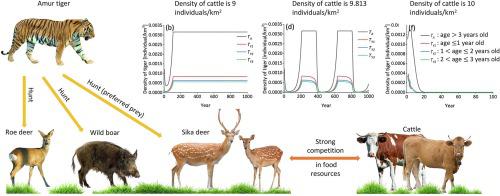当前位置:
X-MOL 学术
›
Ecol. Indic.
›
论文详情
Our official English website, www.x-mol.net, welcomes your feedback! (Note: you will need to create a separate account there.)
Regime shift in the interaction between domestic livestock and the deer-tiger food chain
Ecological Indicators ( IF 6.9 ) Pub Date : 2024-03-15 , DOI: 10.1016/j.ecolind.2024.111870 Dawei Wang , Tianming Wang , Francesco Accatino
Ecological Indicators ( IF 6.9 ) Pub Date : 2024-03-15 , DOI: 10.1016/j.ecolind.2024.111870 Dawei Wang , Tianming Wang , Francesco Accatino

|
The effects of grazing on wildlife have received considerable attention. Depending on factors such as its intensity and duration, grazing can impact higher-level species along the food chain through competition for available resources with wild herbivores. However, relatively few studies have investigated whether there are tipping points at which grazing intensity begins to seriously impact wildlife. In particular, studies that assess the impact of overgrazing on food chains that include carnivores remain scarce. We developed a time dynamic, age-structured model for the wild ungulates-Amur tiger trophic chain, including cattle grazing as a disturbance. We explored 1) the impact of cattle grazing intensity on the long-term behaviour of the wildlife population; 2) the effect of demographic parameters on wildlife population viability; and 3) the temporal dynamic impact of periods of heavy grazing on the population trajectory. Our results showed that increasing cattle density reaches a tipping point, triggering a rapid and significant shift in wildlife population size. Below the tipping point, wildlife can coexist with grazing livestock; when cattle density exceeds the tipping point, wild ungulate and tiger populations move towards extinction. In the case of heavy grazing, the dynamics of the wild ungulate population was more affected by its intensity, and the dynamics of the Amur tiger population was more affected by its duration. Our model and results suggest that theoretically wildlife conservation and cattle production can coexist but that serious regime shifts in wildlife populations may occur if grazing intensity exceeds a tipping point. These findings provide new insights useful for developing policies related to balancing livestock and wildlife conservation.
中文翻译:

家畜与鹿虎食物链之间相互作用的制度转变
放牧对野生动物的影响受到了广泛关注。根据强度和持续时间等因素,放牧可能会通过与野生食草动物争夺可用资源来影响食物链上的高级物种。然而,相对较少的研究调查了放牧强度是否存在开始严重影响野生动物的临界点。特别是,评估过度放牧对包括食肉动物在内的食物链影响的研究仍然很少。我们为野生有蹄类动物-东北虎营养链开发了一个时间动态、年龄结构模型,其中包括牛放牧作为干扰。我们探讨了1)牛放牧强度对野生动物种群长期行为的影响; 2)人口统计参数对野生动物种群生存能力的影响; 3)重度放牧时期对种群轨迹的时间动态影响。我们的结果表明,牛密度的增加达到了临界点,引发了野生动物种群规模的快速而显着的变化。在临界点以下,野生动物可以与放牧牲畜共存;当牛密度超过临界点时,野生有蹄类动物和老虎种群就会走向灭绝。在重度放牧情况下,野生有蹄类动物种群动态受放牧强度影响较大,东北虎种群动态受放牧持续时间影响较大。我们的模型和结果表明,理论上野生动物保护和养牛可以共存,但如果放牧强度超过临界点,野生动物种群可能会发生严重的政权转变。这些发现为制定有关平衡牲畜和野生动物保护的政策提供了有用的新见解。
更新日期:2024-03-15
中文翻译:

家畜与鹿虎食物链之间相互作用的制度转变
放牧对野生动物的影响受到了广泛关注。根据强度和持续时间等因素,放牧可能会通过与野生食草动物争夺可用资源来影响食物链上的高级物种。然而,相对较少的研究调查了放牧强度是否存在开始严重影响野生动物的临界点。特别是,评估过度放牧对包括食肉动物在内的食物链影响的研究仍然很少。我们为野生有蹄类动物-东北虎营养链开发了一个时间动态、年龄结构模型,其中包括牛放牧作为干扰。我们探讨了1)牛放牧强度对野生动物种群长期行为的影响; 2)人口统计参数对野生动物种群生存能力的影响; 3)重度放牧时期对种群轨迹的时间动态影响。我们的结果表明,牛密度的增加达到了临界点,引发了野生动物种群规模的快速而显着的变化。在临界点以下,野生动物可以与放牧牲畜共存;当牛密度超过临界点时,野生有蹄类动物和老虎种群就会走向灭绝。在重度放牧情况下,野生有蹄类动物种群动态受放牧强度影响较大,东北虎种群动态受放牧持续时间影响较大。我们的模型和结果表明,理论上野生动物保护和养牛可以共存,但如果放牧强度超过临界点,野生动物种群可能会发生严重的政权转变。这些发现为制定有关平衡牲畜和野生动物保护的政策提供了有用的新见解。



























 京公网安备 11010802027423号
京公网安备 11010802027423号